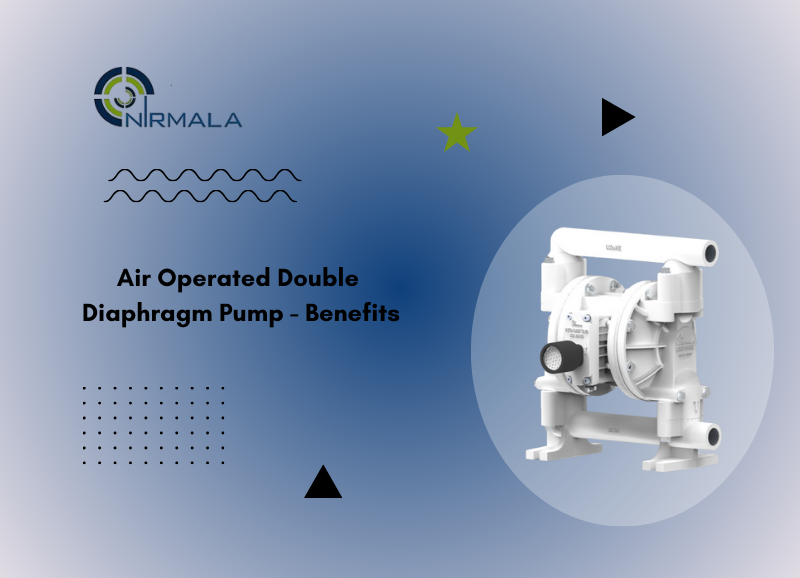Air-operated double-diaphragm (AODD) pumps are employed in a wide range of applications and industries. These pumps are widely used in a variety of industries, including petrochemicals, food, and beverages. Their unusual form makes them perfect for conveying abrasive or viscous materials. An Air Operated Double Diaphragm Pump is a positive displacement pump powered by compressed air. A linked shaft transports compressed air from one chamber to another, allowing the chambers to move at the same time. This back-and-forth action forces liquid from one chamber into the discharge piping while simultaneously filling the other chamber with liquid. Here we are going to discuss all about AODD pumps including their benefits and limitations. So, keep reading!
Working Principle AODD Pump
AODD pumps work with great ease. Compressed air enters the pump and presses against one diaphragm, forcing it to expand into a chamber. At the same moment the other diaphragm contracts, creating a vacuum in a different chamber. This attracts fluid into the inlet valve. As the pressurized air channel switches, the primary diaphragm contracts forcing the fluid out of the discharge valve, and the cycle repeats. The beauty of AODD pumps is in their design.
As there are no spinning parts within the fluid chamber, AODD pumps eliminate the need for complex seals, lowering the risk of leaks and simplifying protection. AODD pumps can handle thick, viscous fluids, slurries, and even fluids that would destroy other types of pumps. Moreover, these pumps can self-prime which means they can start working even if no liquid is originally packed within. This makes them excellent for situations when the fluid supply is placed above the pump.
Benefits of AODD Pumps
AODD pumps offer multiple benefits to various industrial processes. These include:
- An air-operated double diaphragm pump offers numerous advantages over other pump designs. Below are some of the benefits of AODD pumps over other pump types.
- These pumps run on compressed air. This means that they can be utilized in places where an electrical supply is not acceptable, such as hazardous regions.
- AODD pumps can run dry without causing damage or problems.
- Air-powered double diaphragm pumps can handle a wide range of fluid viscosities. A pump that can transfer both high and low-viscosity materials can be employed for a wide range of jobs.
- AODD pumps may also handle corrosive or abrasive fluids, as well as solid or powdered materials.
- These pumps are highly suitable for transporting shear-sensitive media as they have no moving parts exposed to the liquid being pumped.
Limitations of AODD Pumps
Among the drawbacks of compressed air pumps are:
- The compressed air supply affects the AODD pump’s efficiency. The pressure needs to be greater than or equal to the fluid being pumped. The pumps are therefore appropriate for low-pressure applications.
- The air and fluid supply determine the pump speed. Pumping speed can be increased by either a decrease in fluid pressure or an increase in compressed air pressure. To keep the flow steady more flow and pressure control may be required.
- Power and control for the AODD pump are obtained from an air distribution system which is reasonably priced, straightforward, and low maintenance. To collect pollutants certain applications might need to filter the air that is exhaled.
- Inadequately engineered AODD pumps may continuously release air leading to icing issues. By avoiding constrictions lowering the compressed air’s pressure and humidity, or adding a heater you can lessen this.
- The diaphragm’s cyclic motion produces a pulsing discharge. During compression, the fluid accelerates while during suction, it slows down. Pulsation dampeners can be used in discharge pipework to lessen leaks, loose connections, and vibrations.
- Because of the vibrations and the air valves’ continuous venting AODD pumps can be noisy. Mounting a muffler on the air vent line will help to lessen this noise.
Last Words
AODD pumps are a very popular type of displacement pump which are most commonly used in various fluid transfer applications. Their simple design, self-priming capabilities and capacity to transfer harsh fluids make them a valuable asset in a variety of sectors. At Nirmala Pumps we understand the importance of selecting the right AODD pump for your needs. We provide a wide selection of fantastic Air Operated Double Diaphragm Pumps, intended for a variety of applications and manufactured with durability in mind.
Frequently Asked Questions
What exactly is the purpose of an air-operated double diaphragm pump?
AODD pumps are commonly used in chemical processing, wastewater treatment, mining dewatering, paint and ink manufacture, and food product transfer. Their capacity to self-prime and run dry makes them a popular choice in a variety of industrial environments.
How do you manage an air-operated diaphragm pump?
To control an AODD pump’s performance (flow and pressure), install an air pressure regulator assembly in the pump’s air supply line. Most AODD pump installation issues can be solved by installing a suitable airline size and an air regulator.
How effective are double diaphragm pumps?
At zero flow, the pumping concept offers 100% efficiency. AODD pumps are ideal for moving abrasive and shear-sensitive materials, as well as fluids with a high viscosity. They are self-priming, come with optional discharge ports, and can run empty without causing substantial damage or heat buildup.
Why is an air-operated diaphragm pump used instead of a centrifugal pump?
In contrast to standard centrifugal pumps, which are less adaptable, AODD pumps feature a variable working range that can be modified by altering the air pressure via a simple valve. This allows you to choose the appropriate head curve for a certain application or procedure.
What causes diaphragm pump failures?
Running the pump dry is a common cause of diaphragm failure. It sounds obvious, but it is really common. Another method diaphragms might rupture is when the pump is operated at a pressure higher than its maximum rating. Sometimes operators increase the compressed air pressure to speed up the pump’s reciprocating movement.
